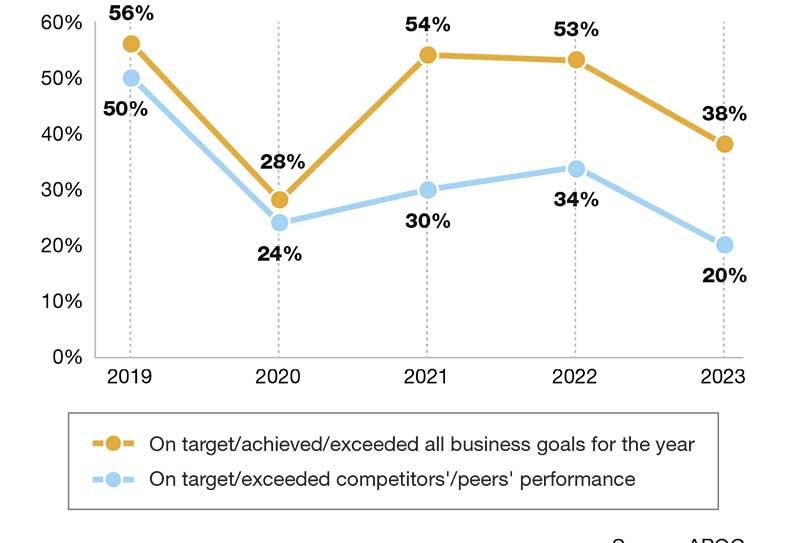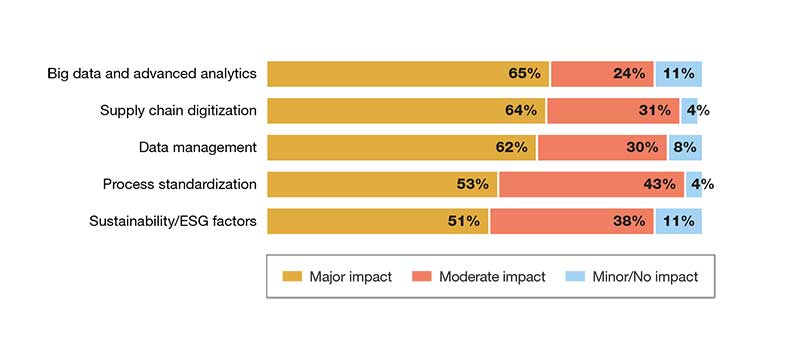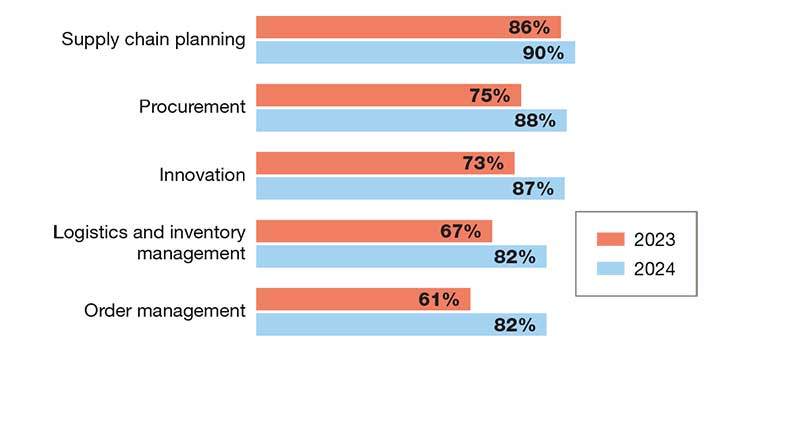With each new year comes a new (and/or continuing) set of supply chain successes and challenges. In early 2024, geopolitical developments and technological advances continue to affect how supply chains and companies conduct business. Internally, businesses must also adjust to more staff reductions and retirements and further develop their new and mid-career supply chain staff. Organizations continue to re-evaluate their approaches and look for ways to improve.
At the beginning of 2024, APQC concluded its 10th annual Supply Chain Management Priorities and Challenges research, including a survey of more than 350 professionals from around the world and across multiple industries. As in previous years, the research examined organizations’ supply chain management priorities, performance, and anticipated trends.
The results reveal that fewer organizations achieved their business goals in 2023. Yet organizations remain focused on the future, with many anticipating further digital developments and investments in their supply chains.
See the related APQC Infographic: Preparedness in 2024
2023 was not an easy year
Although many aspects of business returned to something resembling a pre-pandemic state in 2023, the majority of organizations in APQC’s research did not achieve all of their business goals for the year (Figure 1). Looking back on 2023, we see that a majority of organizations (62%) missed their 2023 targets, and four in five organizations reported falling short of their competitors’ or peers’ performance.
These drops in performance reflect the ongoing uncertainty that supply chains have been facing and continue to face. These results are a cause for concern given that a larger proportion of organizations fared worse in 2023 than in previous years. In 2024, as organizations try to catch up to their peers, they will need to seek new ways to meet their goals while dealing with new and different challenges. Organizations should evaluate which factors make the most impact on their business and determine whether there is the potential for these to affect business goals long-term.
Diving deeper into the data, APQC finds that compared to the previous few years, organizations are trending more positively in terms of performance on specific goals related to customer satisfaction and return on investment (ROI). It is an encouraging sign to see performance on several additional goals trending upward from 2022 to 2023, even though overall achievement remains low. To continue to see improvement in these goals, 2024 needs to be a year of improved flexibility and adaptability for supply chains as global uncertainty continues.
Major trends affecting supply chains in 2024 and beyond
In terms of trends affecting supply chains, research participants anticipate that technological advancements and stronger data and process management practices will make the biggest impact over the next three years (Figure 2). Big data and advanced analytics, supply chain digitization, data management, and process standardization make up the top four trends anticipated to make the greatest impact.
For the third year in a row, big data and advanced analytics is in the top spot. Emerging technologies are helping supply chain professionals make sense of ever-increasing amounts of data, but it’s hard to keep pace with all the internal and external sources. With the digital supply chain, organizations are integrating physical processes with digital data and implementing digital workplace tools, focusing on achieving the desired ROI from these investments.
Strengthening foundational data and processes are in the third and fourth spots for anticipated impacts on supply chain. In its first year on the survey, data management highlights the importance of having well-managed underlying data models, clear data governance, and more critical data-related processes. If the underlying data is not reliable, the decisions the organization makes based on that data are questionable. Just as organizations need a good data foundation, they also need a solid process foundation to maximize efficiency and technology investments. Standardized processes are also key for effective business continuity plans as organizations cope with continued uncertainties and rapid changes in the external environment.
Figure 1: Performance on business goals
Source: APQC
Changes in legal and regulatory requirements and pressure from other stakeholders (e.g., customers, and investors) are driving the impact of sustainability and environmental and social issues on supply chains. But as organizations make public net zero promises, many of them are scrambling to create an actionable plan to hit those targets in time, especially for the more complex Scope 3 emissions from the value chain.
In addition, it is notable that the percentage of respondents anticipating these trends to have a major impact on supply chains has increased substantially over the last year. In the previous year’s research, 34% of respondents expected that big data and advanced analytics would make a major impact, whereas in the most recent survey, an astounding 65% of respondents said this would make a major impact. Similarly, 41% of respondents last year believed supply chain digitization would make a major impact within the next three years, and in the latest survey, that amount jumped to 64%.
Figure 2: Top five trends, innovations, and developments affecting supply chains by 2027
Source: APQC
Obstacles to improvement
APQC also asked supply chain professionals about obstacles to improving their organizations’ supply chain processes. The top four obstacles experienced by respondents are the following:
- implementation of new technologies;
- lack of collaboration across functions and externally;
- lack of governance/poor data management; and
- talent/labor concerns (e.g., staffing shortages or strikes).
Given that technology had such a prominent spot among trends for the next three years, it is not a surprise that the implementation of new technologies has surfaced as an obstacle for 52% of survey respondents. There has been a lot of buzz around new technologies such as the internet of things (IoT), AI, and autonomous vehicles. It can be difficult to identify how to operationalize these technologies within the supply chain, especially AI. Additionally, with the adoption of any new technology comes the need for organizations to address cybersecurity to prevent disruptions caused by security breaches. This obstacle also reflects the increased need for strong change management as organizations sort out their process changes, new roles and responsibilities, and more.
Fifty percent of research participants rated a lack of collaboration across functions and externally as an obstacle to improvement. This obstacle has consistently been rated highly in APQC’s annual research. To address this challenge, APQC advocates for using knowledge management approaches and techniques to provide support and guidance for collaboration. Disconnects in the supply chain can lead to ripple effects that impact customers and their ability to receive orders on time, in full, damage-free, and with accurate documentation. With increased uncertainty, supply chain leaders need effective collaboration to be resilient and responsive. Poor data management and governance also present a foundational issue to supply chains. Having clean, well-managed data is critical to the success of systems across the organization. Having inaccurate data can affect a company’s ability to use analytics effectively, automate activities, and more.
“With the adoption of any new technology comes the need for organizations to address cybersecurity to prevent disruptions caused by security breaches.”
Last year, labor concerns held the top ranking for organizational obstacles. Although 2024 has already had its share of labor challenges, supply chains are not alone when it comes to dealing with labor concerns like strikes, lack of qualified candidates, unfilled vacancies, layoffs, etc. However, given the business-critical role that supply chain plays in getting products and services to the customer, addressing this obstacle needs to be an organizational priority.
Overcoming obstacles
APQC found that organizations are taking a variety of measures to address their supply chain obstacles. Most try to be adaptable in the face of volatile conditions, with 84% of respondents saying that their organizations have re-evaluated or modified their supply chain strategy to overcome obstacles.
In addition, 55% expect to increase their budget for supply chain tools, technology, innovation, and initiatives in 2024. In light of the inflationary environment for businesses, this ensures that supply chains can continue to meet the needs of the business while implementing and operationalizing new technologies.
2024 focus areas
In addition to examining major trends and supply chain obstacles, APQC’s annual research includes insights about organizations’ overall supply chain areas of focus for 2024. An area of focus is one targeted for investing resources, innovation, and hiring. For each area of focus, respondents provided two more detailed priority areas. Figure 3 shows the top five areas of focus for 2024, as well as the corresponding results from 2023.
The 2024 top five areas of focus are the same as in 2023, but in the most recent research more organizations indicated each as a priority. The top area of focus, supply chain planning, was named an area of focus by 90% of respondents—a 4% increase from 2023. For all other areas, there was at least a 12% jump in the percentage of respondents rating each as an area of focus. This increased focus marks an important time for the profession. Supply chains are in the spotlight; now they have to shine and rise to the occasion.
Figure 3: Top five annual focus areas
Source: APQC
Supply chain planning. Respondents focusing on supply chain planning indicated integrated business planning and demand planning and forecasting as their top two priority areas. To address disruptions and global uncertainty, companies need to pull their resources together to ensure that they align business goals and supply chain operations. This leads to the creation of an effective consensus forecast and supports scenario planning to prepare for potential disruptions.
“To make these process improvements stick, leaders must adopt change management practices that address staff concerns and resistance.”
Organizations intend to conduct benchmarking against similar companies, improve collaboration, implement new technologies, and standardize processes to start addressing their supply chain planning priorities.
Sourcing and procurement. Respondents focusing on sourcing and procurement named supplier relationship management, risk mitigation, and sustainability as their top priority areas within this function. Supplier relationship management has consistently been a top priority area within procurement over the years.
This speaks to the need for companies to focus on developing close relationships with key suppliers. APQC advocates for shifting procurement from a focus on transactions to fostering strategic relationships that benefit all parties involved. With increasing regulation related to sustainability, voluntary disclosure in the past has now become required. Many businesses now must disclose and verify their suppliers’ sustainability data or face the threat of financial penalties or disrupted shipments.
The actions organizations intend to take with procurement include implementing new technology and capabilities to increase supply chain visibility. They also intend to further standardize their procurement processes and identify and implement proven practices.
Innovation. Innovation helps organizations stay ahead of the curve even when facing rapid changes, multiple disruptions, and rapid technological advancements in a global context. The top focus area in innovation for 2024 is operational or process innovation, which enables organizations to find new, different, and more effective ways of going to market and operating their organizations and supply chains. It is followed by product and service innovation and creativity as top priorities. There is a large difference between the percentage of respondents selecting operational or process innovation (46%) and those selecting product and service innovation (30%). This speaks to the desire organizations have to find better ways to drive more effective supply chains versus introducing new products or services. To make these process improvements stick, leaders must adopt change management practices that address staff concerns and resistance.
Organizations intend to integrate innovation into organizational goals and implement new technology and capabilities to meet their priorities. They also intend to increase open innovation ecosystem collaboration, embrace new business models, and identify and implement best practices. Overall, companies are looking for new, more collaborative ways to innovate and drive supply chain and enterprise-wide improvements.
A culture of preparedness
APQC’s latest research in priorities and trends for supply chain professionals indicates that 2024 is shaping up to be another challenging year for supply chains. Disturbances continue, such as the volatile freight costs caused by shipping disruptions at the Suez and Panama Canals.
As such, supply chain professionals anticipate that a greater number of trends will make a major impact on supply chains. To address potential obstacles, at least 55% of organizations plan to increase their supply chain budgets. They are also focusing attention on more aspects of the supply chain in 2024.
The theme for supply chains this year is preparation in the face of uncertainty. To support resilience, organizations aim to tackle data governance and management and to leverage new technologies that enable greater visibility and create more effective scenario plans. They also aim to tighten their processes to support clear roles and responsibilities.
In a recent article, Supply Chain Management Review (SCMR) discussed the need for organizations to consider disruptions to be the new norm, and APQC agrees. Strong organizational leadership remains essential for supply chain preparedness and talent management. Leaders can support supply chain professionals who collaborate effectively while embracing the full use of technology. They should also create a culture of preparedness that ensures the entire organization is ready to face almost certain uncertainty. •
About APQC
APQC helps organizations work smarter, faster, and with greater confidence. It is the world’s foremost authority in benchmarking, best practices, process and performance improvement, and knowledge management. APQC’s unique structure as a member-based nonprofit makes it a differentiator in the marketplace. APQC partners with more than 500 member organizations worldwide in all industries. With more than 40 years of experience, APQC remains the world’s leader in transforming organizations. Visit us at apqc.org and learn how you can make best practices your practices.

